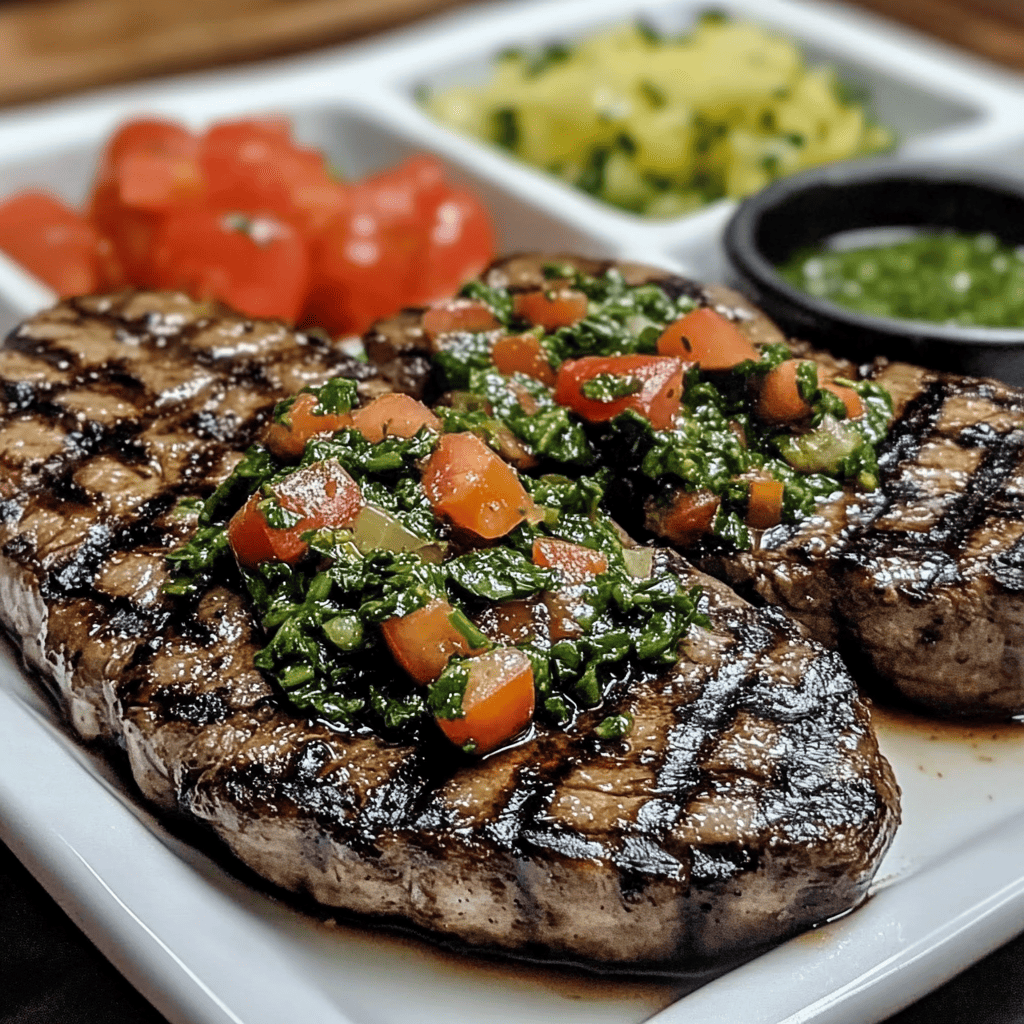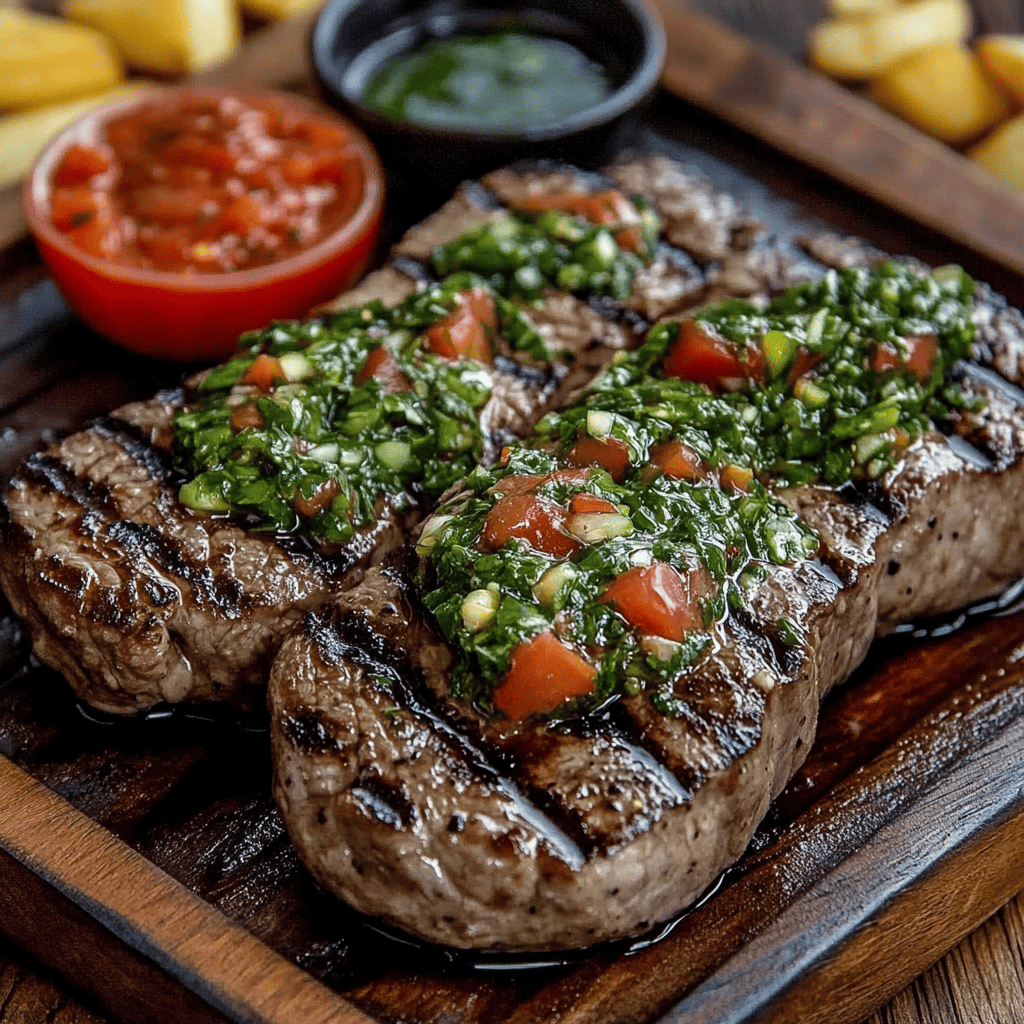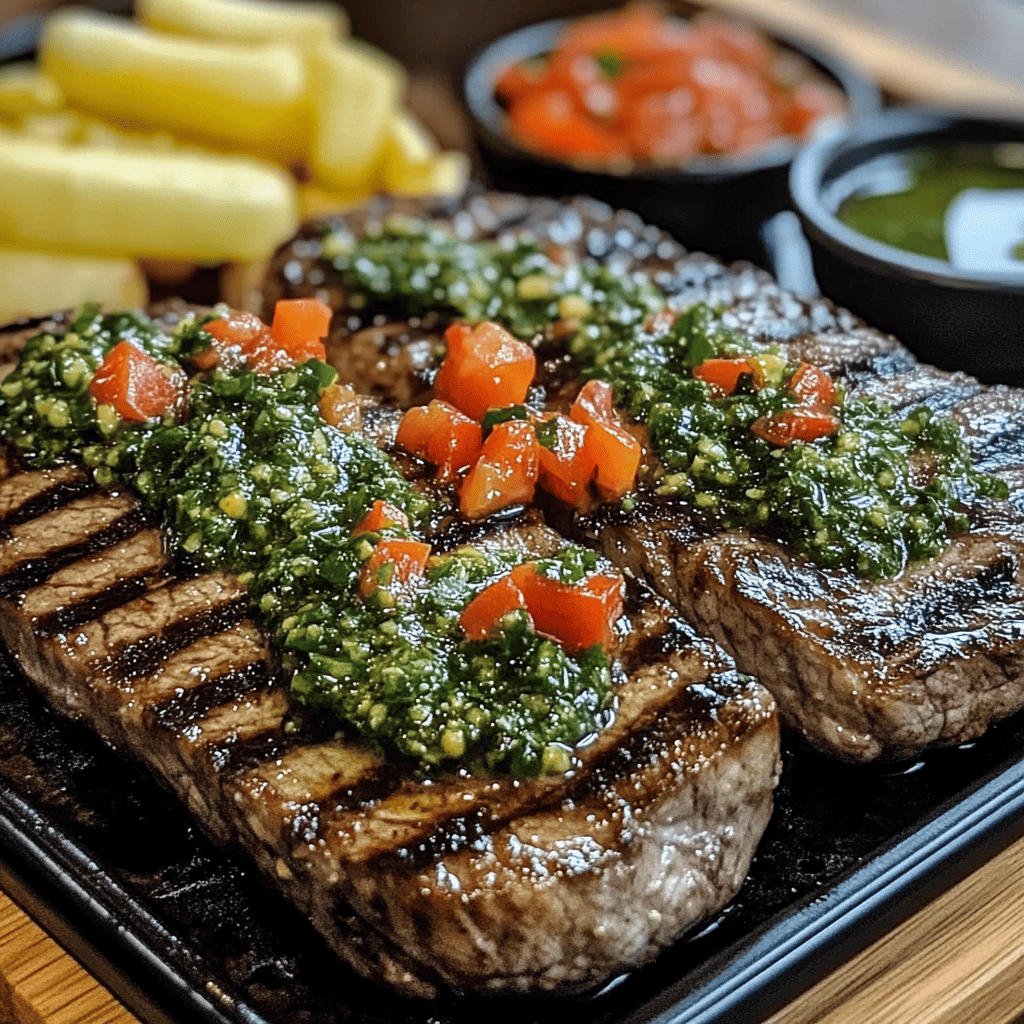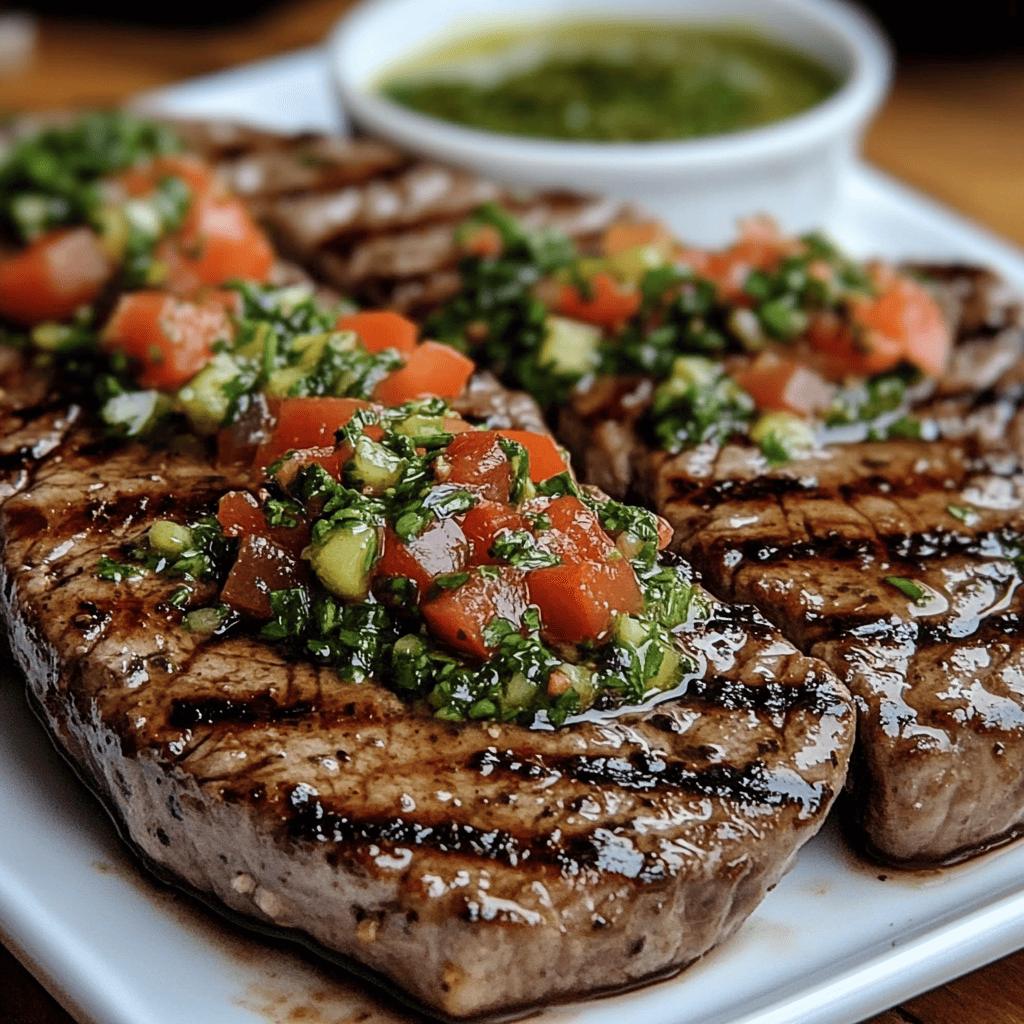Grilled Steak with Chimichurri Sauce: An Argentine Classic That Wins Over Palates
Introduction: The Perfect Marriage of Meat and Aromatic Freshness
Grilled Steak with Chimichurri Sauce is a culinary gem originating in Argentina, which has transcended borders to become an iconic dish in the world of gastronomy. This dish celebrates the simplicity and quality of the ingredients: a good cut of beef, cooked to perfection on the grill, and a fresh, vibrant, and flavorful chimichurri sauce that accompanies and enhances it. The combination of the smoky intensity of the grilled meat with the acidity, spiciness, and herbaceous freshness of the chimichurri is an explosion of sensations in every bite. It’s ideal for barbecues, family gatherings, and any occasion that calls for a striking and delicious main course. Discover all the secrets of this Argentine classic!
Detailed History in Spanish: From the Argentine Pampas to Worldwide Fame
The history of grilled steak and chimichurri sauce is intrinsically Argentine and dates back to the country’s vast pampas, where the gauchos, the region’s cowboys, were the protagonists.
The Origins of Argentine Asado: Asado is more than a meal in Argentina; it’s a social and cultural institution. Gauchos, who lived and worked with cattle, developed grilling techniques that became the heart of Argentine cuisine. They cooked whole cuts of meat (or “asado de tira”) slowly over hot coals, giving them a smoky flavor and unmatched tenderness. Grilled steak is an evolution of these techniques, using individual cuts cooked more quickly.
The Birth of Chimichurri: A Sauce of Mysterious Origin: The origin of the word and sauce “chimichurri” is surrounded by myths and legends, but its connection to Argentina is undeniable.
- The “Jimmy McCurry” Theory: One of the most popular stories suggests that the name comes from an Irish immigrant named Jimmy McCurry (or James Curry) who, during the 19th century, accompanied gauchos and wanted a sauce for his meat. Since he didn’t speak Spanish, people adapted his name to “chimichurri.”
- The Basque Theory: Another theory proposes that the word comes from the Basque word “tximitxurri,” which translates as “mixture of several things” or “mash,” which makes sense given the ingredients of the sauce.
- The “Che mi Curry” Theory: Some suggest that it could derive from an English phrase “give me curry”, pronounced as “che mi curry” by locals, later adapted to chimichurri.
- Origin of Salsa Itself: Beyond the name, salsa itself arose from necessity and ingenuity. Gauchos and European immigrants brought herbs and spices with them. The combination of parsley, garlic, oregano, ají molido (crushed red pepper), vinegar, and olive oil was a simple and effective way to add flavor and freshness to grilled meats, which were often eaten without many accompaniments. The vinegar and oil also served as preservatives.
Chimichurri has become an indispensable accompaniment to Argentine barbecue, offering a flavor contrast that cuts through the richness of the meat and cleanses the palate. The combination of grilled steak and chimichurri is a testament to the simplicity of rural cooking, which, with fresh ingredients and a good fire, can create memorable dining experiences.
More Historical Detail: Chimichurri in Culture and its Variants
Digging a little deeper into the history of Grilled Steak with Chimichurri Sauce, we can consider the following influences:
- The Asado Ritual: The asado in Argentina is not just a meal, but a social event and a ritual that reinforces cultural identity. Chimichurri is an integral part of this ritual. Its preparation is simple, and it’s often entrusted to the “asador” (the person in charge of the grill) or someone close to them, which adds to the camaraderie.
- Chimichurri Variations: Although the basic recipe is consistent, there are two main types:
- Green Chimichurri: This is the most common, with a predominance of parsley and other fresh ingredients. The recipe presented is an example of green chimichurri.
- Red Chimichurri: Includes sweet paprika and ground chili in greater proportion, which gives it a reddish color and a more intense, smoky flavor.
- The Diaspora and Globalization: As Argentines emigrated and Latin American cuisine gained global popularity, chimichurri spread throughout the world. It’s now common in grill restaurants outside of Argentina and has been adapted to different cuisines, including as a dressing for fish or vegetables.
- The Grill Master and the Quality of the Meat: At the heart of the dish is the quality of the meat and the grill master’s skill in cooking it just right. The meat should be well-seared on the outside and juicy on the inside. Popular cuts for steak include sirloin, tenderloin, or skirt steak.
The simplicity of the recipe, the explosion of fresh flavors, and the connection to a rich culinary tradition are what make this dish so enduring and beloved.

Ingredients & Detailed Preparation
Ingredients:
For the Grilled Steak:
- Beef steaks: 2 units (cuts such as chorizo steak, entrail, sirloin, or whatever you prefer)
- Salt: To taste
- Black pepper: To taste
- Olive oil (for the grill, optional): A splash
For the Chimichurri Sauce:
- Chopped fresh parsley: 1 cup
- Chopped garlic cloves: 4 units
- Dried oregano: 1 teaspoon
- Crushed red pepper (ground chili): 1 teaspoon (adjust to taste if you prefer more heat)
- Olive oil: ½ cup
- Salt: To taste
- Black pepper: To taste
Detailed Preparation:
A. Prepare the Chimichurri Sauce:
- Chop the ingredients: Wash the parsley thoroughly and chop it finely. Peel the garlic cloves and chop them very finely or crush them in a mortar until you get a paste.
- Combine dry ingredients: In a medium bowl, combine the chopped parsley, minced garlic, dried oregano, and crushed red pepper.
- Add liquids and season: Pour in ½ cup of olive oil, add salt and black pepper to taste.
- Mix: Mix all the ingredients with a spoon until well combined. The sauce should have a rustic consistency, not a paste.
- Let it rest: To allow the flavors to blend and intensify, cover the bowl with plastic wrap and let the chimichurri sauce sit at room temperature for at least 30 minutes, or ideally in the refrigerator for 1-2 hours before using (remove it from the refrigerator about 15 minutes before serving so the oil doesn’t solidify).
B. Prepare and Grill the Steaks:
- Tempering the meat: Remove steaks from the refrigerator at least 30 minutes before cooking to allow them to reach room temperature. This helps them cook more evenly.
- Season the meat: Just before grilling, pat the steaks dry with paper towels. Season both sides generously with salt and black pepper.
- Preheat the grill: Heat your grill to medium-high heat. Make sure it’s piping hot before placing the meat on it. You can lightly grease the grill grates with a little olive oil (using a soaked paper towel and tongs) to prevent the meat from sticking.
- Grill the steaks:Place the steaks on the hot grill. Cook for 3-5 minutes per side for medium-rare, or adjust the time based on the thickness of the steak and your preferred doneness (use a meat thermometer for accuracy if desired). Look for a nice golden crust on the outside and grill marks.
- Cooking Terms:
- Red/Rare: 52-55°C (125-130°F)
- Medium Red/Medium: 57-60°C (135-140°F)
- Medium: 63-66°C (145-150°F)
- Well done: 70°C (160°F) or higher
- Cooking Terms:
- Resting the Meat: Once cooked, remove the steaks from the grill and place them on a cutting board. Cover them loosely with aluminum foil and let them rest for 5-10 minutes before slicing. This allows the juices to redistribute throughout the meat, resulting in a more tender and juicy steak.
C. Serve:
- Serving: Slice the steaks (if it’s a large cut, like ribeye steak) or serve them whole. Cover each steak generously with the prepared chimichurri sauce.
- Sides: Serve immediately with your favorite sides, such as roasted potatoes, green salad, rice, or grilled vegetables.
Estimated Preparation Time
- Chimichurri Preparation: 10-15 minutes (active) + 30-120 minutes (rest)
- Steak Preparation (tempering and seasoning): 30-35 minutes
- Cooking time for steaks (grilled): 6-10 minutes (depending on the doneness and thickness)
- Resting Steaks: 5-10 minutes
- Total time: Approximately 1 hour – 2 hours 30 minutes (including sauce resting)
Additional Tips
- Quality of ingredients: For an authentic and delicious chimichurri, use fresh parsley and a good extra virgin olive oil.
- Parsley Freshness: Parsley is the heart of chimichurri. Make sure it’s fresh and vibrant.
- Garlic: If you like garlic, you can add one more clove. If not, use a little less.
- Spice Level: The amount of crushed red pepper is up to you. You can add more for a spicier chimichurri, or reduce it.
- Vinegar: Vinegar is crucial for the acidity that balances the fat in the meat. Experiment with white vinegar.
- Marinade (optional): Although chimichurri is usually served as a sauce, some cooks use a portion of the sauce (without the parsley or with less) to marinate the meat for a few hours before grilling, adding even more flavor.
- Meat Thermometer: To ensure perfect cooking, a meat thermometer is an invaluable tool.
- Resting the meat: Don’t skip the step of letting the meat rest. It’s essential for a juicy steak.

Frequently Asked Questions
- Can I use another type of meat? Yes, chimichurri is versatile and pairs well with other cuts of beef, pork, chicken, lamb, and even grilled fish.
- Can I make the chimichurri ahead of time? Yes, in fact, it’s recommended. Chimichurri’s flavor improves with time. You can prepare it 24-48 hours in advance and store it in an airtight container in the refrigerator. Make sure the oil coats the herbs well to prevent oxidization.
- How do I keep chimichurri from oxidizing and retaining its green color? To prevent parsley from oxidizing and turning dark, make sure it’s completely covered in olive oil if you store it in the refrigerator. The vinegar also helps preserve the color.
- What is crushed red pepper? It refers to dried chili flakes, which add a spicy kick. If you don’t have it, you can use a pinch of chili powder or ground chili.
Texture and Flavor
The texture of the grilled steak is a combination of a perfectly seared, lightly charred exterior and a tender, juicy interior that can range from pink to well-done, depending on your taste. The chimichurri sauce adds a rustic texture with finely chopped pieces of parsley and garlic.
The flavor explodes on the palate. The grilled meat offers a smoky, intense flavor, with the natural richness of the beef. The chimichurri sauce is a brilliant counterpart: acidic from the vinegar, spicy from the chili, with the herbaceous freshness of the parsley and oregano, and the pungent aroma of garlic. The olive oil unites all these flavors, creating a vibrant sauce that enhances the meat without overpowering it. It’s a dish with a perfect balance between robust and fresh.
Consumer Context
This dish is ideal for various occasions:
- Roasts and Barbecues: It is the king of any barbecue, whether with family or friends.
- Special Dinners: An excellent option for a main course that will impress your guests.
- Outdoor dining: Perfect for enjoying on a patio or garden.
- Party Menus: Fits well with buffets or meat tables.
- Anytime: For meat lovers, this is a delicious dish any day.
Visual Aspect
Grilled Steak with Chimichurri Sauce is a visually striking dish. The steaks display beautiful grill marks, indicating perfect cooking, with a deep, mouthwatering brown color. The chimichurri sauce is the most striking element, with its bright, intense green color, flecked with the reddish hues of crushed bell pepper and white flecks of garlic. The freshness of the chopped parsley adds a touch of vibrancy. It’s a dish that invites you to savor it with your eyes rather than your palate.
Curiosities
- “Chimi” in Argentina: In Argentina, salsa is often abbreviated as “chimi.”
- Variety of uses: In addition to meats, chimichurri can be used as a salad dressing, marinade, or even spread on bread.
- Uncooked: Chimichurri sauce is a raw sauce, which helps maintain the freshness and intensity of its ingredients.
Nutritional Value (Estimated per Serving)
Please note that these values are approximate and may vary significantly depending on the type and size of the cut of meat, the amount of oil used in the sauce, and the portion of chimichurri consumed.
- Calories: 400-600 kcal (including chimichurri, but varies greatly by cut of meat and size)
- Protein: 30-40 g (from steak)
- Fat: 25-45 g (from meat and olive oil)
- Saturated fat: 8-15 g
- Carbohydrates: 2-5 g (minimal, from herbs and garlic)
- Sugars: Less than 1 g
- Sodium: Variable (depending on the salt added)
- Iron: High (from red meat)
- Vitamins: The sauce provides vitamins (such as Vitamin K from the parsley).
Additional Benefits and Interesting Facts
- Rich in protein: Beef is an excellent source of high-quality protein.
- Antioxidants: Parsley and garlic are rich in antioxidants and beneficial compounds.
- Intense flavor with few ingredients: Demonstrates how the quality and freshness of just a few ingredients can create an exceptional dish.
- Versatility of the sauce: Chimichurri sauce is a wild card in the kitchen, useful for many other dishes.
Other Information
- Storage: Grilled steaks are best enjoyed immediately. Chimichurri sauce stores well in an airtight container in the refrigerator for a week or more.
- Pairing: It combines perfectly with a good Argentine red wine, such as a Malbec or a Cabernet Sauvignon.

Conclusion: A Culinary Journey to the Argentine Pampas
Grilled Steak with Chimichurri Sauce is a celebration of simplicity, quality, and tradition. It’s a dish that transports you directly to the Argentine pampas with every bite, offering the robustness of grilled meat and the freshness of a vibrant sauce. Its preparation is simple, but the result is an unforgettable gastronomic experience. Go ahead, fire up the grill and enjoy this iconic culinary duo that never goes out of style!

